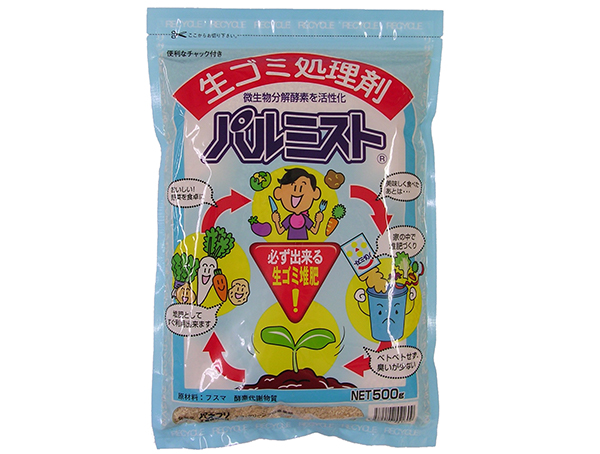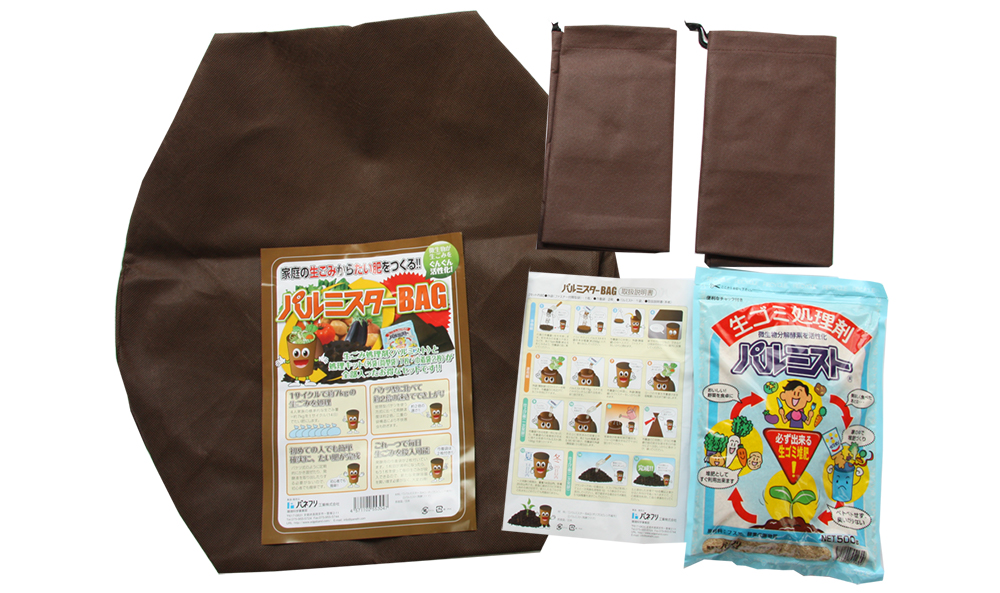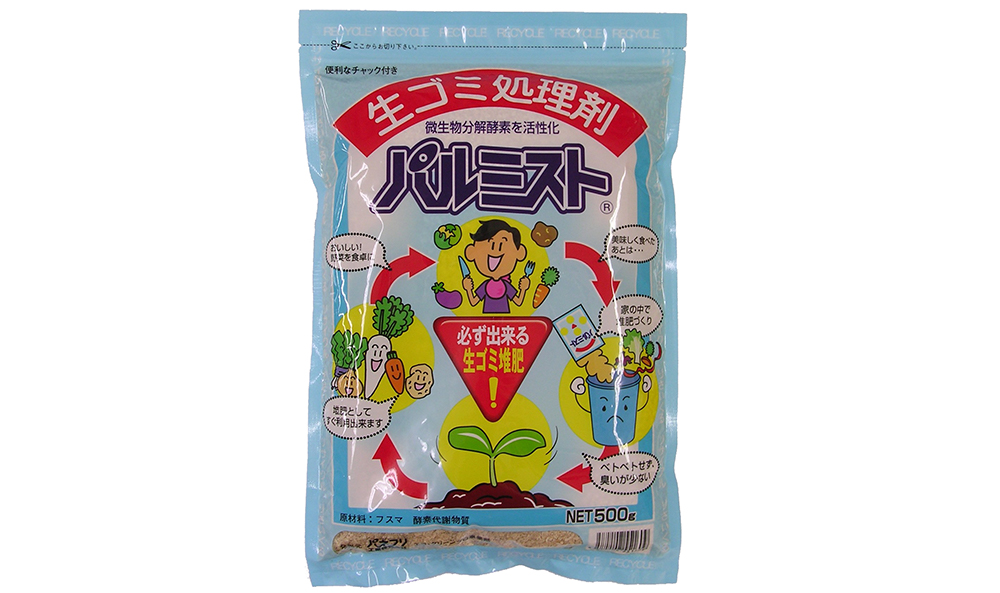Showing all 2 results
Palmist Series
It is easy to make compost with household organic waste.
It takes only 14 days to make compost from about 7 kg of organic waste.
Features
Easy Compost BAG
- Even first-time users can make compost easily.
- With just this bag, you can throw in food waste every day.
- Approximately 7kg of organic waste can be discomposed in one cycle.
- The composing process of Bag type goes up about twice as fast as a bucket type.
Palmist
- Fermentation is fast and easy to decompose, even at low temperatures.
- Fermentation decomposition speed is very fast and it can be used at low temperatures.
- It has the function that decomposes and deodorizes the unpleasant odour of food waste from its source.
- You can use the food waste disposal container you are currently using.
Product types
 |
Easy Compost BAG | This is a great value set that includes a food waste disposal material (Palmist) and a disposal kit (1 outer bag and 2 drawstring pouches). |
|---|---|---|
 |
Palmist | It can compost the equivalent of about 10 days to 2 weeks of food waste. Less unpleasant odour and faster fermentation decomposition rate! Fermentation can take place even at low temperatures. You can also use your bucket container. |
Specifications
Easy Compost BAG
| Contents | 1 outer bag (tube shaped bag with zipper), 2 drawstring bags, 1 bag of palmist, instruction manual |
|---|---|
| Materials | polypropylene nonwoven fabric |
| Delivery lead time | 2-5 business days |
| Cancellation | We do not accept any cancelation after the order is placed. |
| Returns/Changes | We do not accept any returns or exchanges. |
Palmist
| Materials | bran (hull of wheat and other grains), enzyme metabolites |
|---|---|
| Delivery lead time | 2-5 business days |
| Cancellation | We do not accept any cancelation after the order is placed. |
| Returns/Changes | We do not accept any returns or exchanges. |
Note
Is there anything that should not be thrown into the Easy Compost BAG?
Non-food items such as medicines, plastics and tobacco cannot be thrown in. Fish bones and eggshells can be thrown in, but they remain intact for a long time. The same goes for bamboo or corn husks, which are very large in size, so chop them up into small pieces before throwing them into the machine. Please do not throw in hard bones (such as the head bone of a sea bream) that cannot be easily chopped.
How do I prevent the pests?
When storing food waste in a triangular container, be sure to prevent flies and other insects from laying their eggs. Throwing food waste that has already laid eggs on the waste into the bag will not prevent pest infestation. Also, please ensure that the zipper on the Palmister Bag is closed to block the pest pathway to the bag. Place the drawstring bag in the middle and make sure that it does not contact the outer bag, and let the outer bag works adequately as an insect net.
What should I do if a pest infestation occurs?
Fermentation itself will not be adversely affected by unpleasant insects such as fruit flies and fruit flies. The manure will not be affected if you continue to process it as it is, but if it looks unpleasant and you cannot continue then, please bury the entire food waste in the soil. To prevent pests from reappearing, turn the bags over and expose them to direct sunlight a few days before using them. We do not recommend using pesticides as they may leave residues of pesticidal ingredients in the manure.
Palmist
- Since aerobic microorganisms require oxygen, do not cover the container when using a bucket or other poorly ventilated container, and mix well after adding food waste and palmist.
- The temperature rises during fermentation. If you are concerned about insects' invasion, cover on top with a breathable insect net or non-woven fabric.
Easy Compost BAG
【Preparation】
- Put used soil or field soil in the bottom of one of the drawstring bags supplied with the kit, to a height of about 1cm (approx. 0.5L).
- Put about half of the bag (about 250g) of palmist in the bag and soak it lightly.
- Close the drawstring bag and place it inside the outer bag and close the zipper tightly.
- Place the drawstring bag outside, under the eaves, in a garage or other location where it is not exposed to rainwater.
【Operation】
- Unzip the outer bag (tube shape bag). Open the mouth of the drawstring bag and put the food waste inside.
- Sprinkle about 15 grams of palmist on the inside of the bag, just enough to cover the garbage inside.
- Close the mouth of the drawstring and close the zipper of the outer bag (tube shape bag) tightly.Repeat steps 5 to 7 until the bag is about the eighth layer of the drawstring bag.
【Finish Phase I(primary fermentation)】
- Sprinkle thoroughly enough palmist (about 100g) to cover the sediment inside the drawstring bag when the drawstring bag is filled to a certain extent.
- Put in about 1cm high (about 0.5 liters) of used soil, field soil, etc. on top of that, then remove the drawstring bag from the outer bag (tube shape type).
- If the soil is too dry, thoroughly moisten the surface with a jaw-dropper or sprayer.
- Close the mouth of the drawstring bag and wrap the excess part of the mouth two or three times tightly.
- First fermentation should take place within 14 days in summer and 20 days in winter. There is no problem even if the food waste you put in retains its shape.
【Finish Phase II(Secondary process)】
- When used in a planter, use a shovel or similar tool to thoroughly mix the soil and the primary fermentation sediments at a ratio of 10:1. When used in the field, mix about 10 liters per square meter.
- Leave the mixture with the soil for 10 days or more before planting, and use this period to prepare the seedlings.
The key to composting in a bucket
Palmist
- Drain food waste thoroughly.
- Cut organic waste into 1cm pieces to speed up decomposition.
- Reduce the weight ratio of organic waste to palmist to 10:3 and sprinkle palmist over the waste.
- Mix the organic waste and palmist once a day.
Waste that cannot be mixed
Palmist
Seashells, large bones of cattle, chickens, pigs, liquids such as milk, oil, sake, soy sauce, rotten foods, fermented foods (cheese, natto, yogurt, miso), metals, plastics, tobacco, bamboo shoots, skins, ceramics, plastic wraps, seeds.
Storage
Palmist
- The expiration date is 60 days after opening the package.
- Since no sugar is used, it does not ferment inside the container or bag, and it is not sticky on the inside surface of the bag.
- It can be stored at room temperature and is safe to be exposed to air.
- As it does not change its quality by moisture in the air alone, there is no need to worry about humidity.
Palmist
What are the features of Palmist?
Palmist uses aerobic microorganisms to perform fermentation.
As its name implies, aerobic microorganisms are a type of microorganisms that require oxygen for their activities. Traditionally, people in farming communities have been making manure from straw and fallen leaves, and aerobic microorganisms have been used in this process. Palmist is a natural and environmentally friendly way of recycling food waste.
Is it different from EM bacteria?
EM bacteria use anaerobic microorganisms that do not need oxygen when they are active to make manure. For this reason, sealed plastic containers are used for EM bacteria to seal off from the air.
In contrast, the fermentation of Limits is aerobic, so fermentation proceeds about twice as fast as EM bacteria (closed bucket method). It is ideal for converting raw garbage into compost in as short a time as possible.
Product Accessories
What is the purpose of the included drawstring bag?
The drawstring bag is used for primary fermentation by throwing raw garbage into it, and it is put into an outer bag (tube shape bag). The double-layered non-woven cloth bag enhances the insect control effect. Two drawstring bags are included as accessories, so you can use them alternately to throw food waste into the bag every day.
What is the purpose of the included outer bag?
The outer bag (tube shape bag) serves as an insect net to prevent unpleasant insects from approaching the drawstring bag. They are made of non-woven fabric that prevents insects from entering but does not interfere with air flow, and have a zipper attached to the lid. In order to prevent insects from entering the bag, the zipper must be closed every time and the drawstring bag must be placed in the center of the bag to leave a space between the outer bag and the drawstring bag. If the outer bag and drawstring bag are close together, the effectiveness of the insect protection is reduced.
How to use
Where should I place it?
The Palmister Bag is made of non-woven polypropylene and has a water-repellent surface, but is not waterproof. It is not waterproof, but it should be placed under the eaves or under the roof of a parking lot in case of heavy rain.
Why do we have to put soil on the bottom or cover it?
It prevents extreme excess moisture and dryness. If you do not do this, the primary fermentation will not proceed smoothly. It may bother you to do, but please be sure to do it to get the primary fermentation to succeed.
Sprinkling palmist on the surface doesn't make much of a difference.
During the deposition, there is no significant change in appearance. Even after covering it with soil and starting to cure, there may not be any significant changes, but this is not an unusual thing. The curing period of 14 days in the summer and 20 days in the winter is strictly observed, and after the curing period is over, please immediately mix with the culture soil or field soil.
If the curing period exceeds, the accumulated raw garbage will disintegrate like sludge, and the fermentation status will become poor, resulting in decay. As a result, it will cause failure.
Primary Fermentation
What is primary fermentation?
Microbial growth is divided into four phases: the Induction Phase, Logarithmic Propagation Phase, Quiescent Phase, and Death Phase. Primary fermentation in this product is defined as the period from the induction phase to the initial phase of logarithmic growth. In other words, primary fermentation here means the preparation period for microorganisms to adhere to the accumulated food waste in an even manner and enable them to multiply rapidly. This period is carried out in the drawstring bag.
Are there any precautions to be taken when taking out the drawstring bag and starting the curing process?
As mentioned in the instructions, cover it with soil, water it with jowl and moisten it thoroughly as you would irrigate a planter at the start of curing.
What is this white, cottony, fungus-like substance that has grown on the surface?
It is not abnormal, but it is a sign that the microorganisms have started to multiply. Since this indicates good conditions, you should move on to secondary fermentation (mixing with soil), even if it is within the curing period described in the instructions.
Second Fermentation
What is secondary fermentation?
This product is defined as the period from the logarithmic growth period to the resting period. Specifically, the sediment that has undergone primary fermentation (curing in the drawstring) is mixed with soil and allowed to lie down for a certain period. After this period, we are ready to plant crops.
Is it possible to grow flowers using fertilizer obtained from the palmister?
Some flowers are very delicate. The composition and condition of the fertilizer obtained from this product varies depending on the conditions of use and should only be used in vegetable cultivation. Also, avoid excessive use in vegetable cultivation and follow the formula described in the instructions.
Click here for product inquiries




